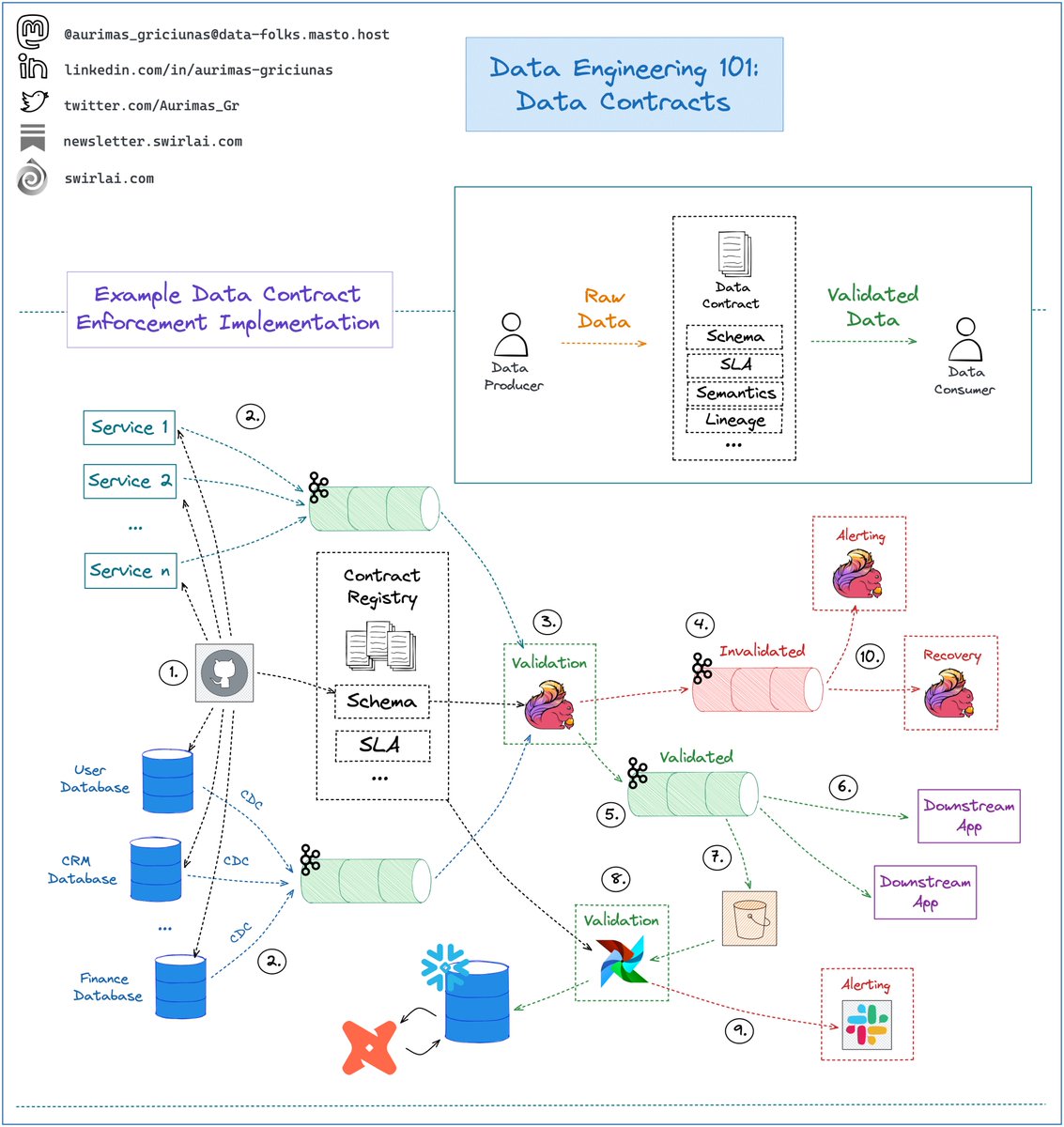
What does a 𝗥𝗲𝗮𝗹 𝗧𝗶𝗺𝗲 𝗦𝗲𝗮𝗿𝗰𝗵 𝗼𝗿 𝗥𝗲𝗰𝗼𝗺𝗺𝗲𝗻𝗱𝗲𝗿 𝗦𝘆𝘀𝘁𝗲𝗺 𝗗𝗲𝘀𝗶𝗴𝗻 look like?
The graph was inspired by the amazing work of @eugeneyan
More in the 🧵
#Data #DataEngineering #MLOps #MachineLearning #DataScience
The graph was inspired by the amazing work of @eugeneyan
More in the 🧵
#Data #DataEngineering #MLOps #MachineLearning #DataScience

Recommender and Search Systems are one of the biggest money makers for most companies when it comes to Machine Learning.
👇
👇
Both Systems are inherently similar. Their goal is to return a list of recommended items given a certain context - it could be a search query in the e-commerce website or a list of recommended songs given that you are currently listening to a certain song on Spotify.
👇
👇
The procedure in real world setups usually consists of two steps:
𝗖𝗮𝗻𝗱𝗶𝗱𝗮𝘁𝗲 𝗥𝗲𝘁𝗿𝗶𝗲𝘃𝗮𝗹.
𝘖𝘧𝘧𝘭𝘪𝘯𝘦(𝘵𝘳𝘢𝘪𝘯𝘪𝘯𝘨) 𝘱𝘢𝘳𝘵:
➡️ We train embedding model that will be used to transform inventory items into vector representations.
👇
𝗖𝗮𝗻𝗱𝗶𝗱𝗮𝘁𝗲 𝗥𝗲𝘁𝗿𝗶𝗲𝘃𝗮𝗹.
𝘖𝘧𝘧𝘭𝘪𝘯𝘦(𝘵𝘳𝘢𝘪𝘯𝘪𝘯𝘨) 𝘱𝘢𝘳𝘵:
➡️ We train embedding model that will be used to transform inventory items into vector representations.
👇
➡️ Deploy the model as a service to be later used for real time embedding.
➡️ We apply previously trained embedding model on all owned inventory items.
➡️ Build an Approximate Nearest Neighbours search index from the embeddings.
👇
➡️ We apply previously trained embedding model on all owned inventory items.
➡️ Build an Approximate Nearest Neighbours search index from the embeddings.
👇
➡️ Define additional filtering rules for retrieved candidates (e.g. don’t allow heavy metal songs for children under 7 years old).
𝘖𝘯𝘭𝘪𝘯𝘦(𝘥𝘦𝘱𝘭𝘰𝘺𝘮𝘦𝘯𝘵) 𝘱𝘢𝘳𝘵:
👇
𝘖𝘯𝘭𝘪𝘯𝘦(𝘥𝘦𝘱𝘭𝘰𝘺𝘮𝘦𝘯𝘵) 𝘱𝘢𝘳𝘵:
👇
➡️ Once an item comes, we embed it into a vector representation using the model from the offline part.
➡️ Use Approximate NN index to find n most similar vectors.
➡️ Apply additional filtering rules defined in the offline part
👇
➡️ Use Approximate NN index to find n most similar vectors.
➡️ Apply additional filtering rules defined in the offline part
👇
𝗖𝗮𝗻𝗱𝗶𝗱𝗮𝘁𝗲 𝗥𝗮𝗻𝗸𝗶𝗻𝗴.
𝘖𝘧𝘧𝘭𝘪𝘯𝘦(𝘵𝘳𝘢𝘪𝘯𝘪𝘯𝘨) 𝘱𝘢𝘳𝘵:
➡️ We build a Feature Store for item level features and expose it for real time feature retrieval.
➡️ Train a Ranking Model using the Features.
👇
𝘖𝘧𝘧𝘭𝘪𝘯𝘦(𝘵𝘳𝘢𝘪𝘯𝘪𝘯𝘨) 𝘱𝘢𝘳𝘵:
➡️ We build a Feature Store for item level features and expose it for real time feature retrieval.
➡️ Train a Ranking Model using the Features.
👇
➡️ Deploy the model as a service to be later used for real time Scoring.
➡️ Define additional Business rules that would overlay additional scores (e.g. downscore certain brands).
𝘖𝘯𝘭𝘪𝘯𝘦(𝘥𝘦𝘱𝘭𝘰𝘺𝘮𝘦𝘯𝘵) 𝘱𝘢𝘳𝘵:
👇
➡️ Define additional Business rules that would overlay additional scores (e.g. downscore certain brands).
𝘖𝘯𝘭𝘪𝘯𝘦(𝘥𝘦𝘱𝘭𝘰𝘺𝘮𝘦𝘯𝘵) 𝘱𝘢𝘳𝘵:
👇
➡️ Chaining from the previous online step we enrich retrieved candidates with features from the Feature Store.
➡️ Apply Ranking model for candidates to receive item scores.
➡️ Order by scores and apply additional business rules on top.
👇
➡️ Apply Ranking model for candidates to receive item scores.
➡️ Order by scores and apply additional business rules on top.
👇
✅ By chaining both Online parts of Candidate Retrieval and Candidate Ranking end-to-end we get a recommendation list that is shown to the user.
✅ Results and user actions against them are piped back to the Feature Store to improve future Ranking Models.
👇
✅ Results and user actions against them are piped back to the Feature Store to improve future Ranking Models.
👇
👋 I am Aurimas.
I will help you Level Up in #MLOps, #MachineLearning, #DataEngineering, #DataScience and overall #Data space.
𝗙𝗼𝗹𝗹𝗼𝘄 𝗺𝗲 and hit 🔔
Join a growing community of Data Professionals by subscribing to my 𝗡𝗲𝘄𝘀𝗹𝗲𝘁𝘁𝗲𝗿: newsletter.swirlai.com/p/sai-17-patte…
I will help you Level Up in #MLOps, #MachineLearning, #DataEngineering, #DataScience and overall #Data space.
𝗙𝗼𝗹𝗹𝗼𝘄 𝗺𝗲 and hit 🔔
Join a growing community of Data Professionals by subscribing to my 𝗡𝗲𝘄𝘀𝗹𝗲𝘁𝘁𝗲𝗿: newsletter.swirlai.com/p/sai-17-patte…
• • •
Missing some Tweet in this thread? You can try to
force a refresh










